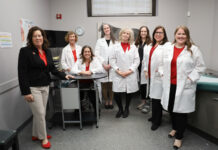University of Louisville researchers have uncovered how to create nanoparticles using natural lipids derived from grapefruit, and have discovered how to use them to deliver medicines.
Huang-Ge Zhang, endowed professor of microbiology and immunology, Qilong Wang, James Graham Brown Cancer Center, and their team May 21 published their findings in Nature Communications.
“These nanoparticles, which we’ve named grapefruit-derived nanovectors (GNVs), are derived from an edible plant, and we believe they are less toxic for patients, result in less biohazardous waste for the environment and are much cheaper to produce at large scale than nanoparticles made from synthetic materials,” said Zhang, who holds the Founders Chair in Cancer Research at the Brown Cancer Center.
The researchers demonstrated that GNVs can transport various therapeutic agents, including anti-cancer drugs, DNA/RNA and proteins such as antibodies. Treatment of animals with GNVs seemed to cause less adverse effects than treatment with drugs encapsulated in synthetic lipids.
“Our GNVs can be modified to target specific cells — we can use them like missiles to carry a variety of therapeutic agents for the purpose of destroying diseased cells,” he said. “Furthermore, we can do this at an affordable price.”
The therapeutic potential of grapefruit derived nanoparticles was further validated through a Phase 1 clinical trial for treatment of colon cancer patients. So far, researchers have observed no toxicity in the patients who orally took the anti-inflammatory agent curcumin encapsulated in grapefruit nanoparticles.
The UofL scientists also plan to test whether this technology can be applied in the treatment of inflammation related autoimmune diseases like rheumatoid arthritis.
A Common Sense Approach
Zhang said he began this research by considering how human ancestors selected food to eat.
“The fruits and vegetables we buy from the grocery today were passed down from generation to generation as favorable and nutritious for the human body. On the flip side, outcomes were not favorable for our ancestors who ate poisonous mushrooms, for example,” he said. “It made sense for us to consider edible plants as a mechanism to create medical nanoparticles as a potential non-toxic therapeutic delivery vehicle.”
Zhang and his team also analyzed the nanoparticles from tomatoes and grapes. Grapefruits were chosen for further exploration because a larger quantity of lipids can be derived from this fruit.




























